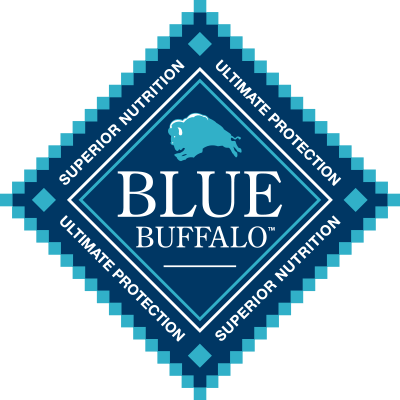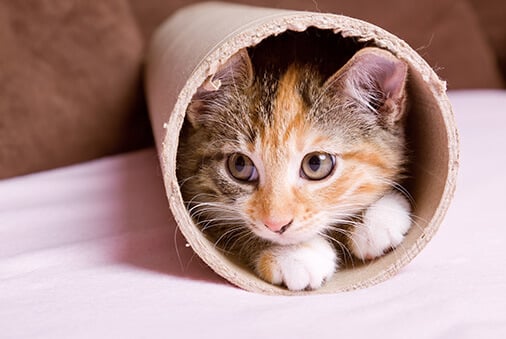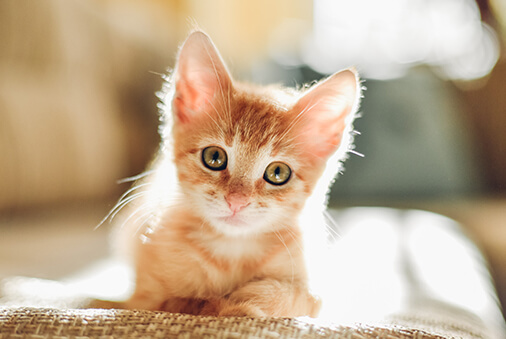What’s the difference between kitten and adult cat food?
If you’re wondering if cat food made especially for kittens is really necessary, the answer is yes. Based on decades of research by the U.S. government, educational institutions, and pet-food companies, the Association of American Feed Control Officials’ (AAFCO) feeding guidelines say your kitten needs more calories, fat, and protein to support their growing body, and kitten food is made with those nutritional needs in mind. A fat- and protein-rich diet is essential at this stage because your kitten is growing and developing quickly.
Foods like BLUE Tastefuls Kitten and Wilderness Kitten dry and wet foods are specifically designed to give growing kittens the nutrients they need without any fillers or by-products. Both formulas contain nutrients that help promote brain and eye development, healthy muscle growth, and essential energy your kitten needs to play the day away.
Plus, all BLUE dry formulas contain a precise blend of nutrients and antioxidants called LifeSource Bits, which also provide immune support and life stage benefits for your growing little one.
Make sure to note the suggested serving size on kitten food labels — you may need to adjust depending on your feline’s specific development.
How much to feed a kitten
As soon as your kitten comes home, it’s essential to focus on good nutrition right from the start. It’s recommended to feed your kitten a mix of wholesome wet and dry food for the first eight to 12 weeks. As your kitten develops their tastes and preferences, experiment with different flavors and textures to find their favorites.
You should feed your kitten three to four meals a day for the first six to nine months to keep up with their activity levels and rapid development. Here’s a fun fact: growing kittens need as much as three times more calories and nutrients than adult cats! Their small stomachs can’t hold the necessary amount of food they need for energy every day if you only feed them once or twice.
Once your kitten hits a year and their growth slows down significantly, you can reduce their feedings to twice a day.
Here’s a suggested feeding chart based on your kitten’s weight:
Recommended Daily Feeding Chart |
|||
|
Kitten Weight in lbs. |
Cups per day |
||
| 1 to 4 mos. | 4 to 9 mos. | 9 to 12 mos. | |
|
1 to 3 lbs. |
¼ - ½ | ¼ - ½ | |
|
4 to 6 lbs. |
½ - ¾ |
½ - ¾ |
¼ - ½ |
|
7 to 10 lbs. |
¾ - 1 |
½ - ¾ |
|
|
Over 10 lbs. |
|
1 + ¼ for each 2 lbs. over 10 lbs. |
¾ + ¼ for each 2 lbs. over 10 lbs. |
Use a standard 8-oz. measuring cup.
Note: Your cat’s feeding needs may vary from this chart due to age, breed, environment, and activity level. Adjust their food as needed to maintain optimal weight and ask your veterinarian if you’re unsure.
Keep an eye on your cat’s weight, not their food
When gauging portions, watch your cat’s body, not their bowl. Food that’s vanished without a trace or left behind doesn’t necessarily mean your cat isn’t getting enough calories or nutrients. The higher calories in kitten food may make them feel full quicker. Your cat’s nutritional needs are determined by their individual metabolism and body type, not a predesignated amount of food.
Keeping track of your cat’s weight can be an important indicator when it comes to portion size. You can weigh them at your veterinarian office — oftentimes this is free of charge. If you’d prefer to stay home, and have a scale, weigh yourself while holding your cat, then weigh yourself alone and subtract the two to figure out your cat’s weight.
If you’re concerned about your cat’s size or weight gain, and you’ve already switched to an adult cat food, it could mean they need fewer servings per day or less food at each meal.
How long should cats eat kitten food?
Your veterinarian can recommend the best time to start feeding adult food based on your cat’s specific needs. Since obesity is the most common nutrition-based issue for domestic pets (it can cause orthopedic problems in older cats), it’s crucial adult cats switch to adult cat food.
Switch slowly from kitten to adult food
The secret to successfully switching cat foods? Taking your time. Mix a small amount of the adult food with your cat’s favorite kitten formula, and slowly increase the amount over 10-14 days, while simultaneously decreasing the kitten food.
By then, you should only be feeding your cat adult food. Changing their food gradually makes them less likely to experience gastrointestinal issues.





